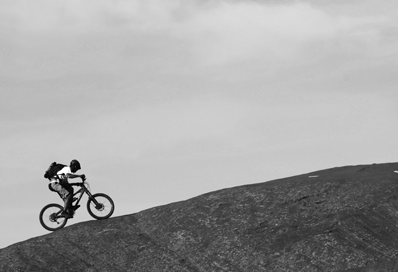Effective Climbing for Cyclists

Developing power for uphill climbs is one of the most challenging cycling skills to master, but it is also one of the most important to ensure you become the best you can be. If you want to improve your cycling performance, you need to work on the techniques needed to take on any type of hill.
Long, Steady Climbs
Longer climbs that consist of a lasting distance require constant effort. Aim to keep your cadence between 80 and 90 RPM, but never drop below 70 RPM, and cycle at a pace a little lower than you think you can maintain to allow for steeper sections. Try not to change gears for the entirety of the climb, but if you must, do so infrequently. Stand occasionally to give different muscle groups the chance to rest.
For longer hill climbs, you’ll want to cycle in a different position than how you ride flat stretches by sitting slightly further back in the saddle. This will give you a longer leg extension and more leverage. As you do so, you can also ensure that your breathing remains uninhibited by relaxing your upper body and pulling back your shoulders to allow your chest to open.
On extra-long climbs, you can stretch while on the bike by standing up and pushing your hips forward, taking the strain off your lower back. In addition, release the tension in your shoulders by lengthening your neck and rolling your shoulders backward.
Cycling over Rolling Terrain
To maintain your speed over undulating terrain, you really need to keep gears and cadence unchanged to the greatest extent possible. Aim to keep your cadence between 70 and 90 RPM, as any higher and you will lose your momentum, while a lower cadence will make it difficult to preserve a steady rhythm.
Start by choosing a gear with which you can climb the rolling terrain, and only shift down if your cadence begins to drop. As soon as you can see the crest of the hill, shift the gear up until you reach the top. At the start of the next roller, continue at the same intensity, gradually increasing your effort as you begin to climb. Stand up once your cadence drops by 5 RPM, but do not shift down a gear until you have dropped another 5 RPM.
If you are working on rolling hills for interval training, you will want to take a different approach. During the climbs, push as hard as possible, once again keeping to a regular rhythm, and use the descents as recovery.
Tips for All Types of Climbs
Meditation
Staying relaxed as you climb will allow your energy to be directed to your legs rather than being wasted in tense areas of the body. Begin by relaxing your jaw and work down your body until you reach your feet, which should rest lightly on the pedals. You can take relaxation a step further by aiming for a meditative state, thinking calming thoughts while you cycle rhythmically.
Lactate Threshold
The key influencer of power and speed is lactate threshold, which you can improve through steady state interval training once or twice per week, recommends Bicycling. Begin cycling three 10-minute intervals with 10 minutes recovery. After some time, progress to two 20-minute intervals with 20 minutes recovery and finally a single 30-minute interval.
Peak Force Intervals
Another way to get your body used to hills is climbing with big gears. To do this, your legs must exert more force with every pedal stroke, which will help prevent fatigue during long events. On a long hill of uniform grade, practice shifting to a harder gear for two minutes and back to your regular gear for a five- to 10-minute recovery, repeating until you reach the top of the hill.
You may not love hills, but you will love the difference that working on your climbing capacity has on your cycling as a whole. Use this as inspiration to increase your effort, and watch how the results improve.

